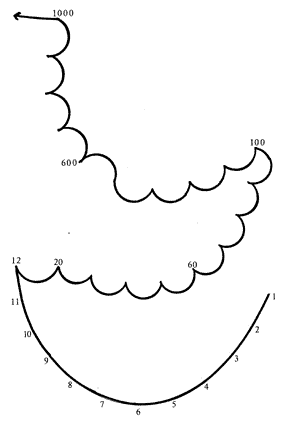
 |
| It shows: | My concept of numbers. It is only an approximation to my internal representation. |
| This is what you see: | The fundamental structure
of my concept is a deeply sagging garland. However, it is not sagging like
a line (which would form a straight line viewed from above), but it is curved
in a semi-circle. The first garland stretches from 1 to 12, with its low at 6. Each following decade is a garland of ist own. The decades form their own garland up to 100, and the same is true for the hundreds. This concept continues in the same way for 10,000, 100,000 ... In any case the low is a number with 6 (16, 26, ... 60, 600, ...). Obviously this follows the positions of the digits on a clock. The lines on the drawing are not a part of my concept, I only see the numbers. The lines are only included to mark the structure. |
| What I could not show better and what's missing: | I had great difficulties
with showing the area of thousands. I "see" the first hundreds from "outside",
and starting with 500 I step into the garland in a way. Therefore, the direction
seems to change suddenly in the picture, but "in reality" this happens smoothly.
When calculating, I look at the respective numbers like through a magnifier, the garlands from 13 to 20 or from 420 to 430 have approximately the same size as the one that extends from 1 to 12. In my imagination the garlands are not arranged in a steep ascend as might be assumed from the picture; they have a deep structure as if they were hung on posts on a large place. The posts are marked by 1, 12, 100, 1000 etc. and are continuously increasing in height slightly. When operating with numbers, I am moving in a way on this number place to and fro between the garlands, therefore they become larger if I approach them. |